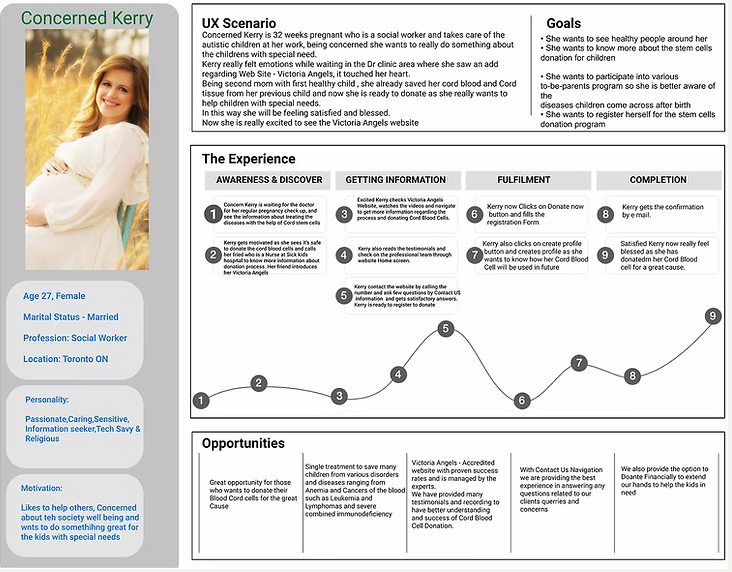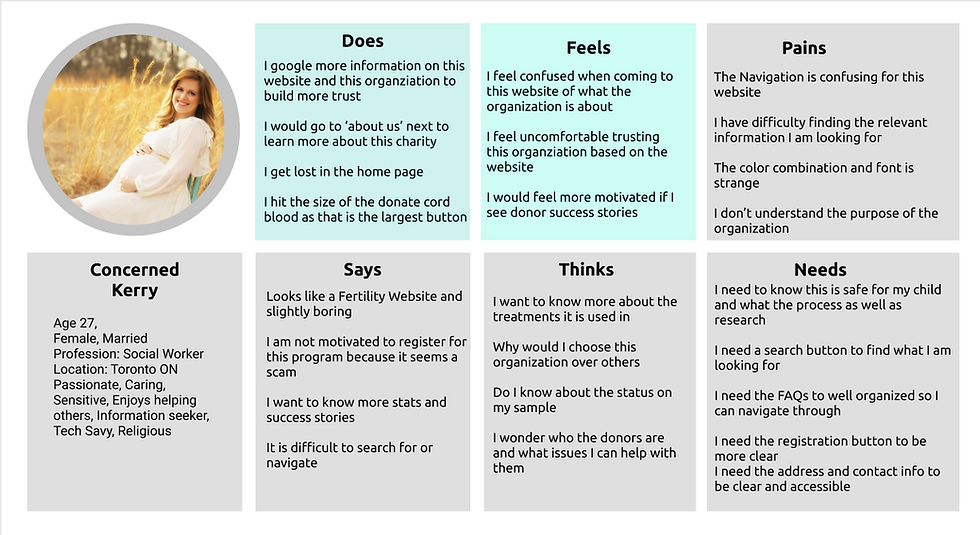User Journey Mapping
The user journey map for "Concerned Kerry" plays a critical role in visualizing the emotional and behavioral path of a potential donor navigating the cord blood donation process.
As a UX researcher, this map helps us identify Kerry’s motivations, touchpoints, and emotional highs and lows—from initial awareness to successful completion. For instance, Kerry’s emotional engagement peaks when she learns about the benefits of stem cell donation through a heartfelt story and dips slightly during the information-gathering phase, signaling a need for clearer, more accessible content.
This journey map not only highlights opportunities to enhance the user experience—such as streamlining information and offering empathetic support—but also guides design and content decisions to align with the user’s emotional needs and goals.

Revolutionizing Cord Blood Registration for Improved Health Outcomes.
Client: Insception Lifebank (Healthcare)
Role: UX Researcher & Designer
Duration: 4.5 months
Team: UX Researcher (me), Product Owner, Medical Advisor, Compliance Officer, Frontend Developer

Goals
Redesign the prenatal cord blood banking registration process to increase completion rates and ensure legal compliance while maintaining patient empathy and clarity.
Discovery & Research
Problem Statement
Expectant parents were struggling to complete the digital registration for cord blood banking due to confusing medical terminology, long form fields, and a lack of clarity on steps involved. Many gave up and called customer service, causing backlogs.

Competitor Analysis
-
All four platforms exhibit strong branding and clear calls to action, particularly around donation processes.
-
Canadian Blood Services stands out for its consistent visual identity and live chat support, while SickKids excels in testimonial use and visual storytelling.
-
Overall, the analysis emphasizes the need for a clear, visually balanced, and emotionally resonant design that supports trust and action—critical factors for a successful cord blood registration experience.
Research Methods Used

User Interviews
Conducted 15 interviews with expectant parents across Canada (first-time and repeat users).

Contextual Inquiry
Observed live registration calls with customer service agents.

Survey
Sent to 200 recent registrants; 64% cited the process as "Stressful & Unclear"

Heuristic Evaluation
Identified usability issues with information hierarchy, terminology, and error handling.
Key Insights
-
Users were often overwhelmed and emotionally charged due to pregnancy-related stress.
-
Many didn’t understand the medical or legal terminology.
-
The form wasn’t mobile-optimized, though 78% accessed it via smartphones.
-
Parents wanted reassurance, humanized language, and clear visuals of next steps.



These proto-personas helped us quickly map out user goals, such as understanding the benefits of cord blood banking, and pain points like complex medical jargon or unclear donation steps.
Proto-Persona


While these personas were assumption-based, they provided a foundation for guiding user research, shaping interview questions, and informing the initial design direction. As we gathered real user data, we refined these proto-personas into evidence-based personas to better reflect user needs and improve the registration experience.
User Persona
Strategy & Planning
Design Goal
User Flow
Create a compassionate, step-based registration flow
Simplify Content
Use plain language and visual cues for medical/legal concepts.
WCAG 2.1
Ensure WCAG accessibility compliance.
Build Trust
Build trust through tone, design consistency, and security reassurance.
Design & Iteration
Wireframes & Prototypes
-
Created low-fidelity wireframes and clickable mid-fidelity prototypes in Figma.
-
Designed key moments: informed consent, agreement form, payment, and appointment booking.

Usability Testing

Round 1 - Low-Fidelity
Users confused by placement of consent form and hidden fees.

Round 2 - Mid-Fidelity
Users appreciated visual timeline of steps; still hesitant about data security.

Round 3 - High-Fidelity
Iterated design led to 92% task completion and positive feedback on flow and tone.
Key Iteration Made
-
Replaced jargon with plain language (e.g., “Informed consent” → “Your permission to store your baby’s cord blood”).
-
Added reassuring microcopy and tooltips.
-
Built mobile-first layout and large touch targets.
-
Used warm colors, soft edges, and inclusive imagery.

Final Product
-
Step-by-step guided registration process
-
Plain-language consent form with expandable help content
-
Mobile-first design and accessible layout
-
Visual timeline of what to expect from registration to delivery
-
Confirmation and reminder emails built into flow

Challenges Faced
-
Balancing empathy with legal compliance in copy
-
Addressing anxiety-driven user behavior in a digital flow
-
Navigating HIPAA-equivalent regulations in Canadian healthcare data design
Lessons Learned
-
Emotional design is critical in healthcare—it’s not just about functionality.
-
A well-defined tone of voice is a powerful UX tool.
-
Mobile-first thinking is essential, especially for prenatal users juggling schedules and devices.
